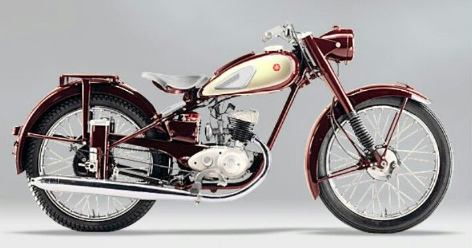
The steam engine was invented in the mid-1800s. It was not long after that that inventors put the bicycle and the engine together and created a motorised motorbike. Ernest Michaux, son of the inventor of the boneshaker bicycle, Pierre, soon had the machine in much demand by the public. Other inventors took the idea and using alternative motors soon had the public mobile on their bicycles. These were a coal-burning furnace and an alcohol burner chamber. In 1981 Lucius Copeland attached a steam engine to a Penny Farthing bicycle.
The next big stride in motorcycles was in 1885 when Germans Daimler and Maybach produced the first bike with a petrol internal combustion engine. This “Riding Wagon” named the Daimler Reitwagen is considered the opening of modern motorcycles. Since the practicality of this combination of bike and engine, many other inventors came up with their versions.
In 1895, ten years after the Daimler Reitwagen hit the road another pair of Germans, Hildebrand and Wolfmuller, started mass producing motorcycles but did not stay in business long. Popular demand increased, resulting in an increase in production at the beginning of the 1900s. These included the English Royal Enfield, the Triumph, the American Harley-Davidson and the Indian. The German’s Dampf Kraft Wagon (the DKW) built by Auto Union quickly became the most significant production bike in the world. After the Second World War army surplus and used army bikes were available at low cost and clubs formed throughout America and Europe.
Transportation
Motorbike became the main form of transportation in Asia. The Japanese were making inroads into the market with the production of the Yamaha, the Suzuki, the Kawasaki, and the Honda. Their motorbikes proved to be cheaper and less troublesome than their American and British opposition bikes. Honda’s Super Cub sold 100 million units, which are the most significant production of any bike type. In 1990 the Japanese domination of the motorbike world weakened. This was due to the introduction of the Western bike builders’ reliable bikes, – the Harley-Davidson, BMW, and Ducati, amongst others.
Numbers
Today over 200 million bikes are in service throughout the world. Countries where motorbikes dominate the road, are China with 34 million and India with 37 million. In 2015, India sold 48 000 bikes every day with 46 000 sold daily in China. The downside of motorbike riding is that the American Department of Transportation has revealed that fatalities per vehicle mile travelled are 37 times higher than for cars.
Motorbikes today are produced in three classes, the street bike, the off-road bike, and the dual-purpose bike for on and off-road use. From these three categories, various other types of bikes have developed from cruisers to mopeds and motocross off-road bikes.
Electric Bikes
Due to the slow depletion of fossil fuels, electric motorbikes have been developed. These motors are also emission-free and silent. Drawbacks are the limited range of the batteries and the low top speeds.